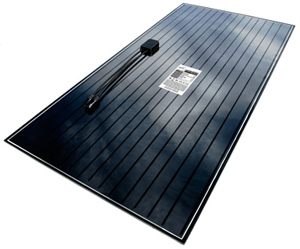With the economy and job-growth stagnant, oil still spewing from the BP well-head into the Gulf of Mexico as a toxic reminder of our addiction to fossil fuels, President Obama couldn’t have picked a better time to announce a major solar power initiative than today, July 3rd — only hours away from Independence Day.
The president labeled his weekly radio address “A Solar Recovery,” reflecting the emphasis on pocket-book voting in this election year. Personally, I wish Obama would have gone with “Energy Independence Day,” putting the spotlight on the larger, long-term prize. But I guess that explains why I’m a journalist and he’s The President of the United States of America.
“We’re accelerating the transition to a clean energy economy and doubling our use of renewable energy sources like wind and solar power…” the president said and then announced a new commitment to solar power of $2 billion.
The bulk of the money will be used to build the world’s largest solar power plant, a 280-MW station in southwestern Arizona. The Solana generating plant, said Obama, “will be the first large-scale solar plant in the U.S. to actually store the energy it generates for later use — even at night.”
Solana (Spanish for “sunny place”) will be built and operated by Abengoa, headquartered in Seville, Spain. The plant will use concentrating solar power (CSP) technology, which uses heat generated by sunlight to produce electricity. Most Americans are more familiar with photovoltaic (PV) solar panels used mostly on rooftops to generate electricity.
Electricity generated by Solana will be purchased by Arizona Public Service, the state’s largest utility, and used to supply electric power to an estimated 70,000 homes.
“This is very encouraging news,” Pat Dinkel, VP for power marketing and resource planning at APS, told The Sun today. “We know there are a lot of steps remaining before our customers can benefit from Solana’s generation but this action brings that goal a step closer.”
Abengoa’s Fred Morse thanked Arizona Congresswoman Gabrielle Giffords (D-Tucson), a leading solar advocate in Washington.
“Congresswoman Giffords played an instrumental role to make this project a reality,” said Morse. “She understands the importance of creating jobs in Arizona and the ripple effects that this project will create throughout the Arizona economy. Solana will bring Arizona one step closer to becoming the solar capital of the nation.”
The Solana project has been in the works for at least three years. With the federal loan guarantee, construction on the plant may begin yet this year.
Secretary Chu: U.S. leadership in the global green economy
Secretary of Energy Steven Chu touted the second part of today’s announcement — $400 million to Abound Solar Manufacturing to produce a new form of PV cells. Plants in Longmont, Colorado, and Tipton, Indiana will manufacture Cadmium-Telluride panels, a technology developed at Colorado State University, the National Renewable Energy Laboratory (NREL) and the National Science Foundation.
The Indiana plant was originally built for a Chrysler auto parts supplier, but because of the recession, it had never been occupied. By 2013, Abound hopes to be manufacturing 840 MW worth of solar panels a year at the two plants.
“By supporting new cutting-edge solar manufacturing technologies,” said Chu, “we are advancing a diverse renewable energy portfolio while helping to position the U.S. at the forefront of the global green economy.”
Jobs for Arizona & New Mexico, too
The Solana plant will need nearly a million specially-made mirrors to reflect and concentrate the Arizona sunlight, and miles of tubing to carry the super-heated liquid used in the CSP process. A mirror factory is planned for the Phoenix area, and the tubes will come from neighboring New Mexico, where a factory owned by Schott Solar is currently operating well-below capacity.
The Solana plant will cover 3,000 acres of former farmland. While CSP that uses water for cooling is controversial, especially in the desert, the power plant will use less water than the farm that had been at the same location. According to Rep. Gabrielle Giffords office, Solana will use slightly more than 10 percent of the water drawn by the farm.
Solana generates electricity without producing greenhouse gasses — eliminating an estimated 470,000 tons of GHG a year.
Some 3,200 giant parabolic collectors will track the sun throughout the day at Solana. Each collector is 25-feet wide, 20-feet high and the length of 1.5 football fields. Some of the heat generated by the collectors will be stored as molten salt, allowing the plant to generate electricity for six hours after sunset.
- Watch the video of the President’s address
- Solana on the APS Website
- Representative Gabrielle Giffords
- Abound Solar
- Abengoa white paper on trough technology (pdf)
Filed under: All,CO2,Downloads,Fossil fuels,Intl.,Laws,Media,Renewables,Solar,Southwest
Trackback Uri










